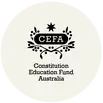60,000 BC
The first Aboriginal people have already arrived in Australia
For over 60,000 years the Aboriginal and Torres Strait Islander Peoples have inhabited the Australian continent, living with the land as their nation and in accordance with systems of law and custom. Distinct tribal groups inhabited hundreds of district territories with over 250 languages spoken.
 Aborigines using fire to hunt kangaroos Source: Joseph Lycett, National Library of Australia
Aborigines using fire to hunt kangaroos Source: Joseph Lycett, National Library of Australia

1780 BC
King Hammurabi of Babylon in Mesopotamia created over 200 written laws known as the Code of Hammurabi
508-322 BC
In Ancient Greece Athenian Democracy included voting and a written Constitution
Regarded as the beginnings of democracy the democratic government of Athens rested on three main institutions: the Assembly of the Demos, the Council of 500 and the People’s Court. Citizens (just free men) voted by a show of hands. The idea of the rule of law can be traced back to Athens. Aristotle wrote: "it is better for the law to rule than one of the citizens."
 Democracy in Ancient Greece, the school of Athens by Raphael in Vatican
Democracy in Ancient Greece, the school of Athens by Raphael in Vatican

509-27 BC
The Government of the Roman Republic was advised by a senate composed of elected magistrates
930 -979
Raiding Vikings brought the concept of a Parliament to the Isle of Man in England
1066
William the Conqueror invaded England and gave some land ownership to the Barons, establishing a feudal system
1215
The Magna Carta gave people the right to justice and a fair trial
Tyrannical King John of England was forced by the Barons to seal an agreement known as “The Great Charter” at Runnymede. Everybody, even the King, was then subject to the law. After centuries of Kings being able to tax any person any amount, or throw anyone in jail, Magna Carta gave all "free men" the right to justice and a fair trial.
 Inspeximus issue of Magna Carta, 1297 Source: Parliament House Art Collection
Inspeximus issue of Magna Carta, 1297 Source: Parliament House Art Collection

1236
The word Parliament was first used in England to describe an assembly between the King and his advisors
1642-1651
Decisions made by King Charles I without Parliamentary consent triggered the English Civil War
1653
The Instrument of Government was enacted as a constitutional settlement following the English Civil war
1689
The Bill of Rights was enacted by the Parliament in England
After the Glorious Revolution King James II fled England and the Bill of Rights was enacted by the English Parliament. It limited the power of the King and bolstered the power of Parliament. It included the requirement for Parliament to meet regularly, for free elections and freedom of speech. It also included the prohibition of cruel and unusual punishment. This revolution permanently established Parliament as the ruling power of England.
 1803 Allegorical engraving representing the 1689 Bill of Rights Source: Hume’s History of England
1803 Allegorical engraving representing the 1689 Bill of Rights Source: Hume’s History of England

1717
The English Transportation Act allowed judges to send convicted criminals to British colonies as convicts
1760-1840's
The Industrial Revolution marked the end of the feudal system
The transition from hand production methods to machines turned Britain into a worldwide trading empire with colonies from North America to India. It also marked a change in political sentiment as the rise of the business man meant successful merchants started clamouring for political representation in the Parliament. The power of the aristocracy in the Government was substantially reduced. The decline of feudalism also brought enormous change to the structure of society.
 Machines making cotton thread
Machines making cotton thread

1765 to 1783
The American Revolution and the creation of the US Constitution was triggered by the animosity against paying tax to Great Britain without any political representation
1788
The eastern part of continent of Australia was colonised by the British and called New South Wales
The British arrived in Sydney, taking the view that the land did not belong to anyone (Terra Nullius). They brought English statute law and the common law. Governor Phillip had been given instructions by King George III on how to run the penal colony and to treat the Aboriginal peoples well. 751 convicts and 213 soldiers reached New South Wales on the first fleet and the British were keen to ensure this colony was different from the American experience.
 Capt. Arthur Phillip raising the British flag Source: State Library of New South Wales
Capt. Arthur Phillip raising the British flag Source: State Library of New South Wales

1748 to 1799
New ideas about how to restrain the monarchy spread during the Age of the Enlightenment and caused the French Revolution
1791
Former convict James Ruse was given the first land grant near Parramatta in the Colony of NSW
1800
Great Britain joined in an ‘Act of Union’ with Ireland to create the ‘United Kingdom of Great Britain and Ireland’ with Irish representatives in the Westminster Parliament.
1823
Moves were made towards achieving self-government in the Colony of NSW
The New South Wales Judicature Act was passed in Britain and provided a Legislative Council and the beginnings of a Parliament in NSW. The penal colony became a settled colony with the establishment of a civil government, civil courts and trial by jury. 5 to 7 members of the Council were appointed to advise the Governor and taxes could only be levied for local needs.
 By John Eyre Source: State Library of New South Wales
By John Eyre Source: State Library of New South Wales

1824
The first sitting of the Supreme Court of New South Wales with Francis Forbes as Chief Justice
1824 – 1832
Legislative Councils were created in New South Wales, Van Diemen's Land and Western Australia
1828
The first NSW census counted less than 40,000 people and found that 24% of the settler and convict population were born in the Colony
1840-42
The first elections were held in Australia
Australia’s first election was held on 31 October 1840 for the Adelaide City Council. Nearly 600 property owning men who had lived within the municipality for at least 6 months voted. Women, aliens and anyone that had been imprisoned within the previous two years were excluded. Local government elections were held in Sydney and Melbourne in 1842.
 Adelaide post office in the 1800s Source: State Library of Victoria
Adelaide post office in the 1800s Source: State Library of Victoria

1843
An election was held for the reconstituted NSW Legislative Council with 24 elected members and 12 appointed
1850
The Australian Constitutions Act passed by the British Parliament allowed the Australian colonies to establish their own constitutions, responsible government and parliaments.
1854-1856
New South Wales, Victoria, Tasmania and South Australia each obtained new Constitutions and responsible government.
1856
The first inter-Colonial Conference was held
The colonies of the Australian continent began to realise that there were particular matters on which they needed to work together. With shipwrecks a regular occurrence off the coasts of the colonies, the first Conference discussed the maintenance of the lighthouses. Over 80 inter-Colonial Conferences were held prior to federation. Meanwhile Victoria pioneered the secret ballot in 1856.
 Hell's Gates lighthouse, Strahan, Tasmania
Hell's Gates lighthouse, Strahan, Tasmania

1857
Worried about the withdrawal of British troops the Victorian Government formed Parliamentary Committees on federation
1859-1867
Queensland was separated from NSW as a new colony in 1859. Its Parliament enacted a Constitution in 1867
1868
The end of convict transportation to the Australian colonies
With free settlers concerned about the society that was developing in the Australian colonies, the arrival of convict ships had been abolished in most colonies. Western Australian companies still required cheap convict labour and transportation had continued there. The last convict ship, the Hougoumont, arrived in Fremantle on 9 January with 279 prisoners.
 HMS Hougoumont Source: State Library of Western Australia
HMS Hougoumont Source: State Library of Western Australia

1870
British troops left Australia and each Colony was now responsible for its own defence
1880
At an Intercolonial Conference NSW Premier Henry Parkes pushed for the implementation of a Federal Council
1883
A Bill to constitute the Federal Council of Australasia was drafted by Queensland Premier Samuel Griffith
1885
English Constitutional Law Professor A.V. Dicey popularised the term 'rule of law'
1885
The Federal Council of Australasia Act was passed. Queensland, Tasmania, Victoria, Western Australia and Fiji joined. New South Wales and New Zealand refused to join and South Australia only joined for 2 years
1889
With the Federal Council disintegrating Sir Henry Parkes made his Tenterfield address in NSW and called for a united Australian nation
1890
Western Australia was the last Australian colony to create their own Constitution
1890
The colonial Premiers met at the Australasian Federation Conference in Melbourne where they agreed to write a federal constitution
1891
The first draft of the Constitution was written on board the Q.G.S.Y. Lucinda on the Hawkesbury River in NSW
The first Constitutional Convention was attended by delegates appointed by the colonial parliaments. Politicians from the colonies were reluctant to give up any power to a Federal Government. Queensland Premier Sir Samuel Griffith, South Australian Premier Charles Kingston and New South Wales delegate Edmund Barton sailed away over the Easter weekend to write the Constitution. A pre-draft Constitution prepared by Tasmanian delegate Andrew Inglis Clark was used as a starting point. Shortly afterwards a recession hit and federation was put aside.
 Delegates to the 1891 Federation Convention in Sydney Source: National Archives of Australia
Delegates to the 1891 Federation Convention in Sydney Source: National Archives of Australia

1893
At the Corowa Conference in NSW it was agreed that to achieve federation elected delegates should write a Constitution that the people vote on at a referendum
1895
South Australian women were able to vote and hold a seat in Parliament
Suffragettes persuaded the South Australian Government that allowing women to vote would be politically advantageous. Legislation was tabled by Premier Charles Kingston to allow women to vote with the expectation that it would fail on the floor of Parliament. However it passed. SA women were granted the right to vote and were the first women in the world able to stand for and hold a seat in Parliament. Catherine Helen Spence was the first woman to put herself forward for election in 1897 when she ran unsuccessfully as a delegate for the second Constitutional Conventions.
 Suffragette Catherine Helen Spence Source: State Library of South Australia
Suffragette Catherine Helen Spence Source: State Library of South Australia

1897-98
The second Constitutional Convention was held in Adelaide, Sydney and Melbourne
10 delegates were elected from each of the colonies except Western Australia who appointed their delegates and Queensland who did not attend. The delegates attended three Constitutional debating and drafting sessions over 82 days. The debates, held in three locations, focused on incorporating the responsible government from the separate colonies into a federal structure. Finding agreement was at times difficult. The final draft was then sent to the people at a referendum, which failed in NSW.
 The Convention in Sydney 1897 Source: NSW Parliamentary Archive
The Convention in Sydney 1897 Source: NSW Parliamentary Archive

1899
The colonial Premiers met in Melbourne and compromised on issues, including financial changes and placing the capital in a territory in New South Wales at least 100 miles from Sydney
1899
Referendums were held in all colonies except WA
Successful referendums were held in five colonies where the people approved the Constitution. Many viewed the Constitution as very democratic for its time. The people of NSW were convinced by the changes to the Constitution made by the Premiers’ Conference. The Colonial Government of Western Australia was still reluctant to join the new federation.
 The 1899 referendum in Queensland Source: State Library of Queensland
The 1899 referendum in Queensland Source: State Library of Queensland

1900
(March) Australian delegates sailed to Britain where minor changes were made to enable appeals to the Privy Council before the Constitution was passed by the British Parliament as section 9 of the Commonwealth of Australia Constitution Act
1900 (9 July)
Queen Victoria gave Royal Assent to the British Act in London and the Constitution became law
1900 (31 July)
Sentiment changed in the West and the people of WA agreed to join the federation at a referendum
1900 (17 September)
In England Queen Victoria proclaimed that the Commonwealth of Australia would come into existence on 1 January 1901
1900 (29 October)
In England Queen Victoria signed the Letters Patent constituting the office of Governor-General of Australia and appointed Lord Hopetoun to that position
1900 (14 December)
Our first Governor-General Lord Hopetoun arrived in Melbourne and in what is known as the ‘Hopetoun blunder’ commissioned anti-federationist William Lyne to form a government. Lyne failed and handed back his commission.
1901 (1 Jan)
The Constitution of the Commonwealth of Australia came into effect











